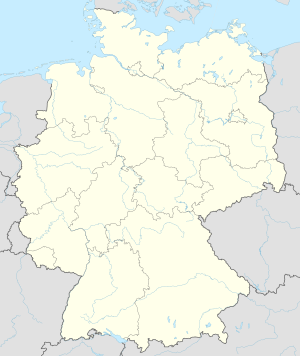Schloss Körtlinghausen
| Schloss Körtlinghausen | |
|---|---|
| Soest (district), North Rhine-Westphalia Germany | |

Schloss Körtlinghausen from the south
2014
|
|
| Coordinates | 51°27′41″N 8°24′37″E / 51.46139°N 8.41028°E |
| Type | Château (Schloss / Moated manor house) |
| Site information | |
| Condition | Restored |
| Site history | |
| Built | 1746 (present version) |
| Architect | Justus Wehmer |
Schloss Körtlinghausen is a Baroque Schloss (château) in Germany's Sauerland region, roughly equidistant between Dortmund and Kassel. It is sited on the southern bank of the River Glenne and it is surrounded by a moat.
Beyond the moat it one of the country's largest and oldest Oak trees, which is more than a thousand years old. The circumference of the trunk just above ground level is 12.4 m (41 ft).
The first documented mention of a castle on the site dates from 1398.
The current château replaced an earlier previous moated fortress. The manor belonged to the and the families till 1447 when it was acquired by the . They were followed by the von Hanxleden who were in their turn succeeded by the von Westrems in 1614. Between 1645 and 1819 it belonged to the family.
In 1714 Franz Otto von und zu Weichs instructed the architect Justus Wehmer to construct a replacement château in the fashionable Baroque style, and the new building was completed in 1746. The von Fürstenbergs acquired it in 1830: it has remained in this family since that time.
In 1945 the château was occupied by the British and became as a holding centre for refugees rendered homeless by ethnic cleansing after large parts of eastern Germany had been transferred to Poland and the Soviet Union under the terms of an agreement between the United States, the Soviet Union and their allies. Between 1956 and 1994 it was rented out for use as a training school for the . Between 1999 and 2004 the château underwent an extensive restoration under the direction of the then owner, Baron Dietger von Fürstenberg, whose work earned him a prize for Historic preservation. In order to finance the work the baron sold a twelfth century German manuscript document, known as the , and which had been in his family for generations, to the Getty Museum in Los Angeles.
...
Wikipedia

